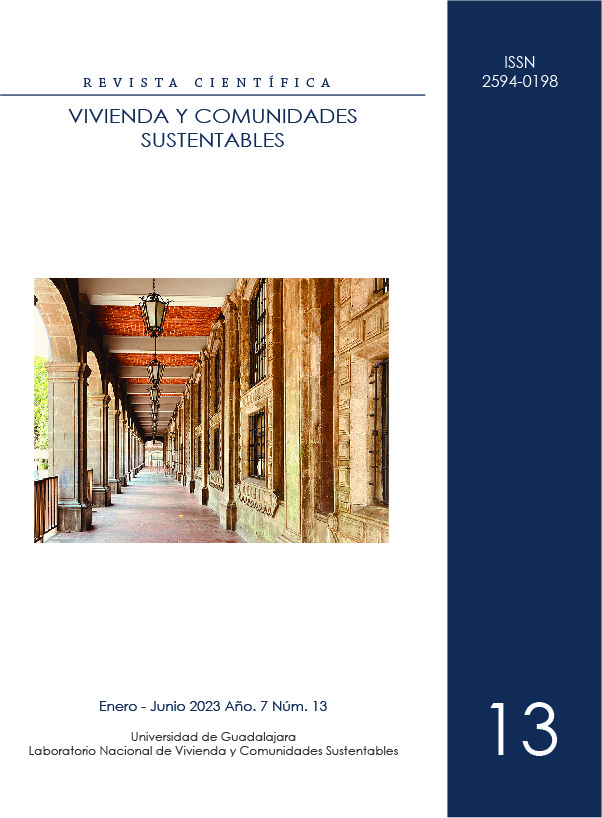Investigations on construction with earth
DOI:
https://doi.org/10.32870/rvcs.v0i13.225Keywords:
earthen construction, sustainability, prototypes, gender perspective in researchAbstract
Housing, refuge of humanity since ancient times has been transformed according to the needs of society: climatological factors, protection against natural disasters and the two pandemics that so- ciety has lived through have radically changed its design. The materials that have been used for its construction have evolved from the natural and sustainable to the processed, therefore, the cons- truction industry has become one of the most po- lluting and it is the responsibility of the builders to look for materials and construction systems with low impact and minimal carbon footprint. Research on sustainable materials and eco tech- niques is scarce; therefore, the objective of this paper is to disseminate earther construction re- search as a possible solution to this problem, pre- senting different construction techniques. The prototypes and research that have been carried out in the Faculty of Architecture, Design and Urbanism of the uat Campus Tampico-Madero, not only seek to validate ancestral techniques as safe, under regulations and laboratory tests, but also to innovate in the search for combinations and sustainable materials. Finally, the discussions address the issue of how the gender perspective affects such research.Metrics
References
Amaratunga, D., Haigh, R., et al. (2006). Construction Women Leaders Final Research Report. Recuperado el 15/05/2022 de http://hub.salford. ac.uk/uprise-centre-for-disaster-resilience/ wp-content/uploads/sites/163 /2020/06/Constructing-Women-Leaders-final-report.pdf
Asociación Brasileña de Normas Técnicas (ABNT). (2012). NBR 13553: Materiales para empleo en paredes monolíticas de suelo-cemento sin función estructural. Río de Janeiro, Brasil: ABNT. Recuperado el 27/09/2022 de https://www.normas.com.br/visualizar/abnt-nbr-nm/10024/ abnt-nbr13553-materiais-para-emprego-em-pa-rede-monolitica-de-solo-cimento-sem-fun- cao-estrutural-requisitos
Castro Pinzón, L. (2019). Factores que afectan el liderazgo de las mujeres en el sector de la construcción. España. Recuperado el 18/05/2022 de https://repository.unimilitar.edu.co/handle/10654 /40486
Chávez, T., Escamilla, N., et al. (2012). Premio Nacional de Vivienda 2012. CONAVI (pp. 40-45, 92-99). México.
Conacyt. (2021). Padrón Beneficiarios del sin. Recuperado el 5/04/2021, de https://conacyt.mx/sistema-nacional-de-investigadores/padron-de-beneficiarios/
Dompe, J. (2021). Mujeres en la construcción. Recuperado el 01/07/2022, de https://www.jll.com. mx/es/views/mujeres-en-la-construccion
Houben, H., y Guillaud, H. (1994). Earth Construction, a comprehensive guide (pp. 164-184). Reino Unido: ITDG Publishing.
Lucotelo, S., y Garza, S. (2017). Cambio climático y desastres: Un enfoque en políticas públicas. México: UNAM. Recuperado el 30/09/2022 https://www.pincc.unam.mx/wp-content/uploads/2021/05/2017-desastres.pdf
Normas Mexicanas del ONNCCE. (2016). Norma para BTC 508-2015. Recuperado el 27/09/2022 de https://www.dof.gob.mx/nota_detalle.php?codigo=5432969&fecha=13 /04 /2016#gsc.tab=0
Norma Técnica Colombiana. (2004). Bloques de suelo cemento para muros y divisiones. (NTC 5324). Recuperado el 02/06/2022 de https://tienda. icontec.org /gp-bloques-de-suelo-cemento-para-muros-y-divisiones-definiciones-especificaciones-metodos-de-ensayo-condiciones-de-en- trega-ntc5324-2004.html
Normas Técnicas complementarias de construcción para el DF. (2017). Diario Oficial de la Federación (DOF). Recuperado el 21/09/22, de http://www3.contraloriadf.gob.mx/prontuario/resources/normatividad/69247.pdf
Rocha, M., y Jové, F. (2015). Técnicas de construcción con tierra (pp. 39 y 83). Lisboa: Argumentum.
Román-Osalo Ríos, P., et al. (2013). Barreras de género en el desarrollo profesional de mujeres en técnicas de la construcción. Recuperado el 01/07/2022, de https://www.scielo.cl/scielo.php?script=sci_ arttext&pid=S0718-915X2013000100009
Secretaría de Economía. (2022). Catálogo de normas mexicanas. Recuperado el 22/09/22, de http:// www.2006-2012.economia.gob.mx/comunidad-negocios/normalizacion/catalogo-mexi- cano-de-normas
UAT. (2021). Anexo estadístico. Universidad Autónoma de Tamaulipas.
Vera, S. (2019). La contaminación atmosférica por las actividades de la industria de la construcción en Colombia. Recuperado el 15/05/2022, de https:// www.researchgate.net/profile/Javier-Vera-So- lano/publication/336749294_Air_pollution_from_construction_industry_activities_in_ Colombia/links/5db0b5fc299bf111d4c022e9/ Air-pollution-from-construction-industry-ac- tivities-in-Colombia.pdf
Downloads
Published
How to Cite
Issue
Section
License
Copyright (c) 2022 Vivienda y Comunidades Sustentables

This work is licensed under a Creative Commons Attribution-NonCommercial-NoDerivatives 4.0 International License.
The authors who publish in this journal accept the following conditions:
In accordance with the copyright legislation, Sustainable Housing and Communities recognizes and respects the moral right of the authors, as well as the ownership of the patrimonial right, which will be transferred to the University of Guadalajara for its dissemination in open access. Sustainable Housing and Communities does not charge authors for submitting and processing articles for publication. Authors may make other independent and additional contractual agreements for the non-exclusive distribution of the version of the article published in Sustainable Housing and Communities (for example, include it in an institutional repository or publish it in a book) as long as they clearly indicate that the work is published for the first time in Sustainable Housing and Communities.






